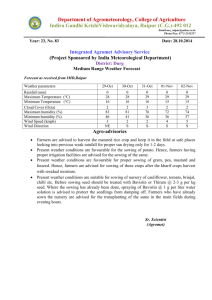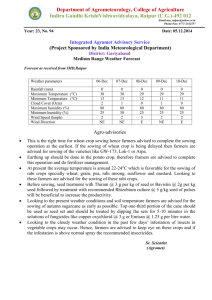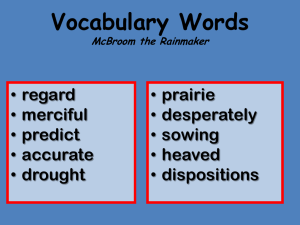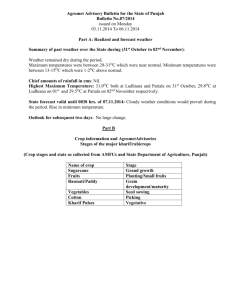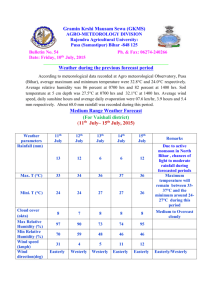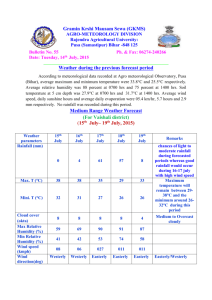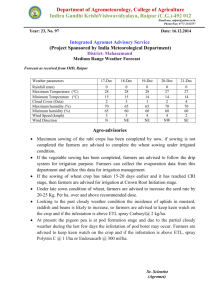Tailoring strategies to rainfall variability – The choice
advertisement
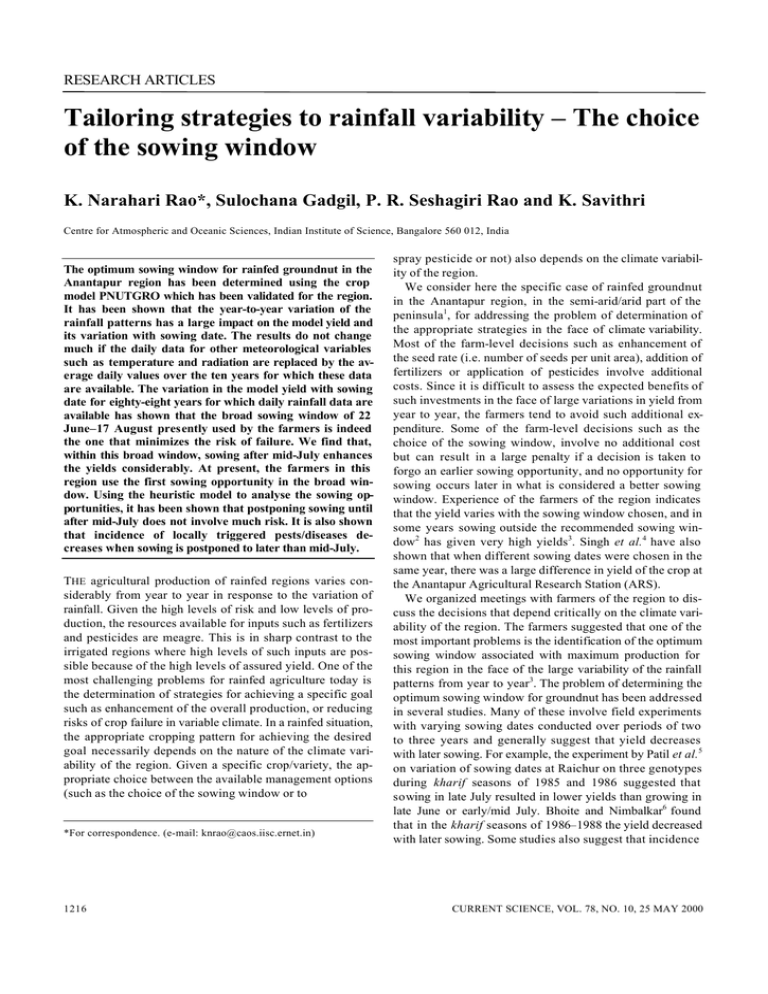
RESEARCH ARTICLES Tailoring strategies to rainfall variability – The choice of the sowing window K. Narahari Rao*, Sulochana Gadgil, P. R. Seshagiri Rao and K. Savithri Centre for Atmospheric and Oceanic Sciences, Indian Institute of Science, Bangalore 560 012, India The optimum sowing window for rainfed groundnut in the Anantapur region has been determined using the crop model PNUTGRO which has been validated for the region. It has been shown that the year-to-year variation of the rainfall patterns has a large impact on the model yield and its variation with sowing date. The results do not change much if the daily data for other meteorological variables such as temperature and radiation are replaced by the average daily values over the ten years for which these data are available. The variation in the model yield with sowing date for eighty-eight years for which daily rainfall data are available has shown that the broad sowing window of 22 June–17 August presently used by the farmers is indeed the one that minimizes the risk of failure. We find that, within this broad window, sowing after mid-July enhances the yields considerably. At present, the farmers in this region use the first sowing opportunity in the broad window. Using the heuristic model to analyse the sowing opportunities, it has been shown that postponing sowing until after mid-July does not involve much risk. It is also shown that incidence of locally triggered pests/diseases decreases when sowing is postponed to later than mid-July. THE agricultural production of rainfed regions varies considerably from year to year in response to the variation of rainfall. Given the high levels of risk and low levels of production, the resources available for inputs such as fertilizers and pesticides are meagre. This is in sharp contrast to the irrigated regions where high levels of such inputs are possible because of the high levels of assured yield. One of the most challenging problems for rainfed agriculture today is the determination of strategies for achieving a specific goal such as enhancement of the overall production, or reducing risks of crop failure in variable climate. In a rainfed situation, the appropriate cropping pattern for achieving the desired goal necessarily depends on the nature of the climate variability of the region. Given a specific crop/variety, the appropriate choice between the available management options (such as the choice of the sowing window or to *For correspondence. (e-mail: knrao@caos.iisc.ernet.in) 1216 spray pesticide or not) also depends on the climate variability of the region. We consider here the specific case of rainfed groundnut in the Anantapur region, in the semi-arid/arid part of the peninsula1, for addressing the problem of determination of the appropriate strategies in the face of climate variability. Most of the farm-level decisions such as enhancement of the seed rate (i.e. number of seeds per unit area), addition of fertilizers or application of pesticides involve additional costs. Since it is difficult to assess the expected benefits of such investments in the face of large variations in yield from year to year, the farmers tend to avoid such additional expenditure. Some of the farm-level decisions such as the choice of the sowing window, involve no additional cost but can result in a large penalty if a decision is taken to forgo an earlier sowing opportunity, and no opportunity for sowing occurs later in what is considered a better sowing window. Experience of the farmers of the region indicates that the yield varies with the sowing window chosen, and in some years sowing outside the recommended sowing window2 has given very high yields3. Singh et al.4 have also shown that when different sowing dates were chosen in the same year, there was a large difference in yield of the crop at the Anantapur Agricultural Research Station (ARS). We organized meetings with farmers of the region to discuss the decisions that depend critically on the climate variability of the region. The farmers suggested that one of the most important problems is the identification of the optimum sowing window associated with maximum production for this region in the face of the large variability of the rainfall patterns from year to year3. The problem of determining the optimum sowing window for groundnut has been addressed in several studies. Many of these involve field experiments with varying sowing dates conducted over periods of two to three years and generally suggest that yield decreases with later sowing. For example, the experiment by Patil et al.5 on variation of sowing dates at Raichur on three genotypes during kharif seasons of 1985 and 1986 suggested that sowing in late July resulted in lower yields than growing in late June or early/mid July. Bhoite and Nimbalkar6 found that in the kharif seasons of 1986–1988 the yield decreased with later sowing. Some studies also suggest that incidence CURRENT SCIENCE, VOL. 78, NO. 10, 25 MAY 2000 RESEARCH ARTICLES of late leaf spot is less with earlier sowing than late sowing7. It is clear that investigations over longer periods are necessary for determining the optimum sowing date for a region such as the Anantapur over which the rainfall pattern varies a great deal from year to year. An effective tool for such a study is a crop model which can simulate the impact of rainfall variation reasonably well. We address the problem of determining the sowing window associated with maximum yield using a crop model. We have also investigated the variation of the incidence of the major pests/diseases with sowing date using a model in which the pests/diseases are triggered by wet and dry spells. The rainfall pattern comprises a succession of wet and dry spells in the monsoonal regions in general and Anantapur in particular (Figure 1). The yield of the rainfed crops in a semi-arid region is a sensitive function of the moisturestress experienced by the crop. If a dry spell occurs in a critical stage, the yield decreases markedly. However, if the sowing date is so chosen that the dry spells occur at stages which are relatively insensitive and wet spells occur at the critical stage, then the yield is very high. Thus the optimum sowing window depends on the probability of wet and dry spells over the region in different parts of the rainy season. The optimum Figure 1. Rainfall at Anantapur during 1982, 1988 and 1997. CURRENT SCIENCE, VOL. 78, NO. 10, 25 MAY 2000 b Figure 2 a. Average weekly rainfall during April–November and the upper and lower limits for 90% of the years and 75% of the years based on the daily rainfall data for Anantapur, 1911–1998; b (Top) Probability of wet spells (rainfall ≥ 1–2 cm), (Bottom) Probability of dry spells (rainfall 0 or < 0.25 cm). 1217 RESEARCH ARTICLES strategy involves tailoring for the given nature of rainfall variability such that dry spells occur at relatively insensitive stages. In any given period or sowing window, farmers sow groundnut seeds only when there is adequate moisture in the soil (see ref. 1 for threshold soil moisture). Generally, in a given season there are several sowing opportunities. If the optimal sowing window is determined then the farmers can utilize the sowing opportunity that occurs in that optimal sowing window. Here we present the results of a modelling study of the optimum sowing window for the specific case of rainfed groundnut (variety TMV-2) in the Anantapur region on the basis of the nature of the rainfall variability during 1911–1998. This region receives rainfall from May to November, with maximum rainfall from mid-September to mid-October (Figure 2). It is seen from Figure 2 that the variation of the weekly rainfall is rather large throughout the rainy season. The traditional cropping system over the region involved several crops of which one was a runner variety of groundnut. Sowing was done at the earliest opportunity in May–June. Thus the rainfall during the entire period from May to November was utilized. Groundnut cultivation on a large-scale began in the mid70s with the introduction of the TMV-2 variety3. In the package of practices for high yields in this region developed by agricultural scientists2, sowing in May–June is recommended for groundnut (TMV-2). It is suggested that in the absence of sowing opportunities in May–June, sowing can be done in July; sowing of groundnut (TMV-2) is not recommended in August. However, farmers on the basis of the experience over a relatively short period of about two decades now use a sowing window from late June to midAugust 3. Farmers use a solar calendar with roughly bi-weekly time periods called ‘nakshatras’ as units (Table 1) and farm-level decisions about timing generally refer to these periods (rather than months or weeks). Generally, sowing is done during 22 June–16 August, i.e. sometime in one of the four nakshatras, viz. Ardra, Punarvasu, Pushya, Ashlesha. It is believed that sowing in Punarvasu (6–19 July) is associated with high yields, Pushya (20 July–3 August) being the next best. Sowing earlier in Ardra (22 June–5 July) or later in Ashlesha (3 August–17 August) is considered to be associated with a high level of risk3. It is important to note that when no opportunity occurs in July, farmers do undertake sowing in August despite the recommendation to the contrary2. This is based on the experience of farmers when August sowing was associated with high yields. It is clear that the nature of the variation of the yield with sowing date for the different rainfall patterns of the region needs to be understood. The PNUTGRO model8,9, which has been validated for TMV-2 at the Anantapur agricultural research station4, 1218 Table 1. Rainfall in different nakshatras at Anantapur (cm) Anantapur rainfall (cm) Nakshatra Duration* Ashwini Bharani Kritika Rohini Mrigashira Ardra Punarvasu Pushya Aslesha Makha Pubba Uttara Hasta Chitta Swathi Vishaka Anuradha Jyeshta Moola Purvashada Uttarashada Sravana Dhanishta Shatabhisha Poorva Bhadra Uttara Bhadra Revati 13 April–26 April 27 April–10 May 11 May–24 May 25 May–7 June 8 June–21 June 22 June–5 July 6 July–19 July 20 July–2 August 3 Aug–16 August 17 Aug–30 August 31 August–12 September 13 September–26 September 27 September–9 October 10 October–23 October 24 October–5 November 6 November–18 November 19 November–2 December 3 December–15 December 16 December–28 December 29 December–10 January 11 January–23 January 24 January –5 February 6 February–18 February 19 February–3 March 4 March–17 March 18 March–30 March 31 March–12 April Mean 0.85 1.23 2.84 3.41 2.31 1.88 2.86 2.78 2.58 4.23 3.50 9.03 6.71 3.80 3.29 0.42 0.98 0.60 0.12 0.24 0.02 0.24 0.03 0.13 0.15 0.24 0.52 Standard deviation 1.55 2.05 3.28 3.53 2.60 2.33 5.13 3.42 3.64 6.47 4.29 7.40 5.65 4.05 4.46 1.13 1.81 1.51 0.52 1.48 0.09 1.50 0.20 0.45 0.61 0.76 0.97 *After IMD14 . has been used to derive the optimum sowing window for this region. Variation of the PNUTGRO yield with sowing date is investigated later in this article. First, the sensitivity of the PNUTGRO model to the inputs of meteorological information, viz. temperature (maximum and minimum), radiation and rainfall is tested. It is shown that rainfall variation has by far the largest impact on the yield. Then the variation of the model yield with sowing dates from May to August is studied. Since the rainfall pattern varies from year to year, the sowing date associated with maximum yield varies from year to year. The optimum sowing window for this region is derived by analysis of the data for eightyeight years for which daily rainfall data are available. In order to understand why the yield is high for the optimum sowing window, the moisture-stress at different stages of the plant for different sowing dates is analysed here and the most critical stage at which rainfall variation has a large impact is determined. An analysis of the sowing opportunities for each year, determined from a heuristic model based on farming practices of the region1, is also presented. The risk involved in not utilizing an earlier sowing opportunity in anticipation of a later one in the optimum window is also assessed. The probability of incidence of pest-diseases derived from the heuristic model CURRENT SCIENCE, VOL. 78, NO. 10, 25 MAY 2000 RESEARCH ARTICLES for different sowing dates is then presented. Finally, the results are summarized and the implications are discussed. Variation of yield with sowing date The variation of yield with sowing date has been investigated using the PNUTGRO model8,9 which can simulate the year to year variation of the yield of TMV-2 at the Anantapur research station (Figure 3 after Singh et al.4). It is seen that the simulated yield is close to the observed yield for most of the years. Generally, the average yield at the district level is less than the model simulated yield, primarily because of the incidence of pests and diseases 10,11. Thus the model yield can be considered as a potential/maximum yield under rainfed conditions. The average yield in this region is about 750 kg/ha. Crop failure is said to occur when the yield is less than 500 kg/ha, since it is inadequate for meeting the costs incurred. Thus we expect a model yield of less than 500 kg/ha to be associated with crop failure, between 1000 and 1500 kg/ha to above-average yield and model yield higher than 1500 kg/ha to very good yield on the farmers’ fields. The optimum sowing date for minimizing risk of crop failure (or maximizing the production) is thus one which corresponds to minimizing the probability of model yield less than 500 kg/ha (or maximizing the probability of model yield above 1500 kg/ha). Sensitivity to different meteorological inputs The meteorological data input required for the PNUTGRO model are the daily values of maximum and minimum temperature, radiation and rainfall. Daily rainfall data for the Anantapur ARS are available from Figure 3. Observed yield (open circles) of rainfed groundnut (TMV2) at the Anantapur Agricultural Station and simulated yield (filled circles) with the PNUTGRO model for 1979–1990 (after Singh et al.4 ). CURRENT SCIENCE, VOL. 78, NO. 10, 25 MAY 2000 1962 to 1998, and data on the other meteorological variables from 1979 onwards. In addition, the daily rainfall data at the Anantapur station of the India Meteorological Department (IMD) are available from 1911 to 1990. We first studied the sensitivity of the model results for variation in yield with sowing date, to the input of rainfall vis-à-vis the other meteorological variables. The variation of the simulated pod yield with sowing date for 1982, 1983, 1985 and 1986 is shown in Figure 4. The results obtained by replacing the observed daily data on temperature (maximum and minimum) and radiation by the daily average data for the period 1979–1988 are also shown in Figure 4. It is seen that the actual yield simulated in the latter case is close to the former. The difference is generally less than 50 kg/ha and the maximum difference is 124 kg/ha. The pattern of variation of the yield with sowing date is the same in both cases. It is clear that rainfall variation has, by far, the largest impact on variation of the yield. Hence, it is possible to use the large rainfall data set on daily rainfall (from 1962 to 1998 at Anantapur ARS and from 1911 to 1961 at the IMD station) in combination with the daily average values of the other meteorological variables to derive the variation of yield with sowing date for a large number of years. Variation of PNUTGRO yield with sowing date The variation of the yield for sowing dates between May and August derived from the PNUTGRO model for the years between 1911 and 1998 for which rainfall data are available is shown in Figure 5. Note that in almost all the years the model yield increases as the sowing date is postponed from May till late June. This is consistent with the present sowing window of 22 June to mid-August arrived at by the farmers after about two decades of experience. The surprising result from Figure 5 is that the yield increases with later sowing even beyond July for many years. The patterns of variation of yield with sowing date fall into six categories. In category I the optimum sowing date is in early July or earlier. In categories II and II the optimum sowing date is between 6 and 20 July. In both cases as the sowing date increases from late June till the optimum, yield increases rapidly. However, for the years in the category III, the yield does not decrease much for later sowing dates. Categories IV and V correspond to optimum sowing dates in early and late August, respectively. We also note that in some years (category VI) the rainfall is so low (e.g. 1984) or so well distributed (e.g. 1917) that the yield hardly varies with sowing date from late June onwards. It is seen that the simulated yield is greater for sowing in late June – early July only for years of category I, i.e. in 19 out of the 87 years. Later sowing is associated with larger (or as much) yield in almost 80% of the years. 1219 RESEARCH ARTICLES Figure 4. Variation of PNUTGRO yield with sowing date for 1982, 1983, 1985 and 1986 with observed values of temperature, radiation and rainfall (filled circles) and with observed values of rainfall and daily average values of temperature and radiation (open circles). The probability of model yield less than 500 kg/ha (i.e. crop failure), between 1000 and 1500 kg/ha (i.e. above average yield on the farmers’ fields) and above 1500 kg/ha (i.e. very good yield on the farmers’ fields) as a function of the sowing date is shown in Figure 6. It is seen that the probability of failure is high (about 40%) for sowing in May or early June. The probability of good yield is less than 20% for such early sowing. These probabilities decrease substantially for sowing from late June onwards. Thus the choice of the prevalent broad sowing window from 22 June is appropriate as one that minimizes the risk of crop failure. We find that within this broad window, the period 15 July–10 August is associated with highest probability of very good yield. The probability of very good yield is markedly less for sowing in the early part of July. Since high 1220 yields are associated with sowing in early July only in about 20% of the years, it is clear that the overall yield will be enhanced if the sowing window is chosen as the first opportunity in Pushya or Aslesha, i.e. between 20 July and 17 August. Detailed comparison of the average yield over the eightyeight years for sowing in the different nakshatras is given in Figure 7 a. It is seen that in comparison with sowing in Ardra (22 June–5 July) later sowing, i.e. in Punarvasu (6–19 July) or Pushya (20 July–2 August) or Aslesha (3–16 August) gives better yields particularly when yields for Ardra sowing are less than about 1750 kg/ha. It is interesting that when the yields for Ardra sowing is more than 1750 kg/ha, the yield for CURRENT SCIENCE, VOL. 78, NO. 10, 25 MAY 2000 RESEARCH ARTICLES Figure 5. Variation of PNUTGRO yield (in kg/ha) with sowing date for 1911–1998. I, Years with maximum yield for sowing in early July or earlier; II, Years with maximum field for sowing between 6 and 20 July and sharp decrease in yield with sowing date after that. sowing in Aslesha (3–16 August) is significantly less. Again, average yield for sowing in Punarvasu (6–20 July) is less than the yield for later sowing when the yield for sowing in Punarvasu is less than 1500 kg/ha. We attempt to understand why later sowing is favoured in this region by considering the variation of the moisture-stress experienced by the plant during different life history stages for optimal as well as sub-optimal sowing dates. CURRENT SCIENCE, VOL. 78, NO. 10, 25 MAY 2000 Moisture-stress, critical stages and optimum sowing date In the PNUTGRO model the moisture-stress experienced by the plant at different stages in the life history is also calculated. Generally, the need for water increases as the plant grows, until the leaf development is complete at the end of about 60 day, and remains high thereafter. Hence, in a region with scanty rainfall such 1221 RESEARCH ARTICLES Figure 5. Variation of PNUTGRO yield (in kg/ha) with sowing date for 1911–1998. III, Years with maximum field for sowing between 6 and 20 July and little change in yield with sowing date after that; IV, in early August. as Anantapur, the moisture-stress also generally increases to a maximum by 60 days and remains high (Figure 8). It is known that moisture-stress at different stages can have an adverse impact on the growth and development of the groundnut plant and hence the yield. The critical stages identified are the vegetative stage, the flowering stage, peg development and pod formation stage and pod filling stage. In the vegetative stage (0–25 days), soil moisture deficit reduces growth of stem and leaves. Moisture-stress during the flowering stage (25–35 days) leads to delays in flowering and a decrease of the number of flowers12. Moisture- 1222 stress during the peg development (35–50 days) and pod formation (50–60 days) stages, can lead to yield reduction in the range of 15–30% of the yield in the well-watered situation12 because of the reduction in the number of pods per plant. The impact of moisture-stress during the pod-filling stage (60–80 days) is also known to be large12,13. The plants for which the sowing date is optimum experience almost no moisture-stress at all during 60–80 days (Figure 8), which differs markedly from the general trend. This suggests that of the different critical periods suggested in the literature, the one with the maximum CURRENT SCIENCE, VOL. 78, NO. 10, 25 MAY 2000 RESEARCH ARTICLES Figure 5. Variation of PNUTGRO yield (in kg/ha) with sowing date for 1911–1998. V, Years with maximum field in late August; VI, Years with relatively little variation in yield throughout the present sowing window of late June to mid-August. impact on yield is the pod-filling stage of 60–80 days. To test this hypothesis, we carried out a series of runs with the PNUTGRO model for the three good rainfall years (1983, 1988 and 1998). For each of these years, the PNUTGRO yield in the run with the observed rainfall pattern was compared with runs in which the rainfall was assumed to be zero in one of the six phenological stages. Thus, in the first experiment for the impact of dry spell in the vegetative stage, CURRENT SCIENCE, VOL. 78, NO. 10, 25 MAY 2000 the rainfall is taken to be zero between 0 and 25 days after sowing, and the same as observed during the rest of the period. The sowing date was chosen to correspond to the optimum one with the maximum yield. The result for 1998 is shown in Figure 9. Let DR be the rainfall in a given stage expressed as a percentage of the total seasonal rainfall. The decrease in yield due to the suppression of 1223 RESEARCH ARTICLES Table 2. Impact of dry spells at different stages Days after sowing Stage Vegetative Flowering Peg Pod forming Pod filling Pod maturity 1983 1988 DR per cent DY per cent DR per cent 6.82 7.38 17.70 8.04 45.17 7.00 2.96 6.76 14.05 1.54 50.22 8.38 15.46 5.87 17.79 30.48 23.19 4.43 0–25 25–35 35–50 50–60 60–80 80–100 Rainfall in that stage DR = 1998 DY per cent 2.45 5.88 11.25 1.78 40.62 6.87 DR per cent 38.75 0.56 3.94 8.13 15.09 3.09 DY per cent 7.40 0.26 13.36 23.67 57.44 2.57 × 100; Rainfall during July to December Decrease in PNUTGRO yield DY = × 100. PNUTGRO yield for observed rainfall pattern a b c Figure 6. Variation of the probability of a, crop failure (PNUTGRO yield <500 kg/ha); b, above average yield (1000 < PNUTGRO yield < 1500 kg/ha); c, good yield (PNUTGRO yield > 1500 kg/ha). 1224 rainfall at that stage expressed as a percentage of the yield associated with the actual rainfall is denoted by DY. The DR and DY values for each stage are given in Table 2 for the three years. It is seen that by far the largest impact is of the dry spell during 60–80 days after sowing. It is interesting that the largest decrease in yield of about 58% in 1998 is associated with only 15% decrease in seasonal rainfall in this period. Thus a strategy for which the probability of dry spells is low during the critical stage (60–80 days) will be associated with high yields. In a semi-arid region such as the one studied, dry spells occur every year. Hence no dry spells at some stage necessarily implies dry spells at other stages. If the sowing date is chosen so that the probability of the dry spell is high in the vegetative stage (0–25 days), there is little impact on the yield. A strategy in which the probability of dry spells during 60–80 days after sowing is minimum, with the period with high probability of dry spell occurring in the first month should be the one associated with maximum yields. The moisture-stress at different stages of the plant for two different sowing dates in 1972 and 1983 is shown in Figure 10 along with the observed rainfall. It can be seen that the moisture-stress changes rapidly in response to changes in rainfall. It increases during dry spells and decreases rapidly to low values within a day or two when rainfall occurs. For each of these years, the later sowing date with the maximum yield is the optimum one. Note that the moisturestress is very high in the critical stage (60–80 days) for the early sowing dates whereas the rainfall in September has resulted in low moisture-stress during this critical stage for the optimal sowing date. It is seen that within the rainy season, the probability of a dry (wet) week is very low (high) during the last two weeks of September and first two weeks of October. On the other hand, the probability of a dry (wet) week is CURRENT SCIENCE, VOL. 78, NO. 10, 25 MAY 2000 RESEARCH ARTICLES a b Sowing Date in Ardra (22 June–5 July) Sowing Date in Ardra (22 June–5 July) Sowing Date in Ardra (22 June–5 July) Figure 7. a, Average yield for sowing in Ardra (22 June–5 July) vs average yield for sowing in Punarvasu (6–19 July), Pushya (20 July–2 August) and Aslesha (3–16 August); b, Average yield for sowing in Punarvasu vs sowing in Pushya or Aslesha and sowing in Pushya vs sowing in Aslesha. Table 3. Land preparation operations Operation First plough Date Condition 1 May to 25 June Sm20 ≥ 0.9Sa20 If the above condition for ploughing is not satisfied before 25 June, crisis ploughing is done. Crisis plough 26 Jun to 30 July Sm20 ≥ 0.75Sa20 If the above condition for crisis ploughing is also not satisfied, cultivation for that year is abandoned. Second plough Harrowing Sowing Late/crisis sowing 7 days after 1st plough or 7 June (whichever is later) to 25 June Sm20 ≥ 0.75Sa20 If the above condition for second ploughing is not satisfied, the first plough is taken as the final plough. Sm20 < 0.75Sa20 for 2 consecutive Final plough date or 15 June (whichever is later) to 16 August days. If the land is not sufficiently dry to harrow, cultivation for that year is abandoned. Harrowing day or 25 June (whichever is later) to 25 July Sm20 ≥ 0.6Sa20 If the land is not sufficiently wet to sow till 25 July, late/crisis sowing is undertaken. Harrowing day or 26 July (whichever is later) to 16 August Sm20 ≥ 0.3Sa20 Day of sowing should be a non rainy day (rainfall ≤ 0.25 mm). Soil depth considered = 20 cm, Sa20 = 28 mm and Sm20 = available soil moisture. CURRENT SCIENCE, VOL. 78, NO. 10, 25 MAY 2000 1225 RESEARCH ARTICLES Figure 8. Variation of moisture-stress with days after sowing for suboptimal sowing dates of some years (top) and for optimum sowing dates of some years (bottom). high (low) in August, particularly so in the first half of the month. Hence sowing between 15 July and 15 August is associated with a high probability of rainfall in the critical stage (60–80 days) and a high probability of a dry spell in the relatively insensitive vegetative phase (0–25 days). Thus the results of highest expected yield for sowing in this window can be understood in terms of avoidance of dry spells in the critical stage. However, whether a decision to postpone sowing till 15 July can be made in reality depends upon the sowing opportunities in the optimal window. Whether the yields will be high also depends on how the incidence of pests and diseases varies with the sowing date. We address these questions next. Sowing opportunities Having identified the optimum sowing window for the region, the next problem is to determine the chance of sowing opportunities during different parts of the present broad 1226 sowing window of 22 June–16 August. We use the heuristic model based on farming practices of the region1 to determine the sowing opportunities for each year. Whether ploughing, harrowing or sowing can be done depends upon the moisture content of the top 20 cm of the soil. The condition of the soil moisture of this 20 cm layer for the different operations is given in Table 3. Note that if there is no opportunity for ploughing until 22 June (i.e. the condition that the soil moisture exceeds 90% of the maximum is not satisfied on any day till then), crisis ploughing is undertaken provided that the soil moisture exceeds 75 per cent of the maximum. Similarly if an opportunity for sowing (i.e. soil moisture greater than 60% of the maximum) does not occur till a prescribed date, then crisis sowing is undertaken provided the soil moisture exceeds 30% of the maximum. We explored the sowing opportunities within each year by the following procedure. For a given year and a CURRENT SCIENCE, VOL. 78, NO. 10, 25 MAY 2000 RESEARCH ARTICLES Figure 9. Variation of the moisture-stress with days after sowing (indicated on top of each figure) for sowing on 30 July 1998 (the optimum sowing date for 1998) for different rainfall patterns with (i) actual rainfall during 1998; (ii) no rainfall in vegetative stage (0–25 days) and actual rainfall on rest of the days; (iii) no rainfall in peg development stage (36–50 days) and actual rainfall on rest of the days; (iv) no rainfall in pod formation stage (51–60 days) and actual rainfall on rest of the days; (v) no rainfall in pod development stage (61–80 days) and actual rainfall on rest of the days; (vi) no rainfall in pod maturity stage (81–100 days) and actual rainfall on rest of the days. given day, say 22 June 1997, we first check whether it has been possible to plough before that date and harrow on or before that date; then we check whether normal sowing is possible. If normal sowing is not possible, we check whether crisis sowing is possible. The number of years in which sowing is possible on each day during May–August is shown in Figure 11. The sowing opportunities for each CURRENT SCIENCE, VOL. 78, NO. 10, 25 MAY 2000 year whether it is normal sowing or crisis sowing are shown in Figure 12. Out of 88 years, in six years the sowing had to be abandoned. Out of these, in four years there was no opportunity to plough whereas in the other years there was no opportunity for harrowing and sowing. In the rest of the years there were several sowing opportunities in 1227 RESEARCH ARTICLES Figure 10. Variation of moisture-stress with time for two different sowing dates in 1972 and 1983. window suggested earlier in the article does not involve any risk. Pests/disease incidence Figure 11. Number of sowing opportunities on different days. different parts of the rainy season. In particular, in 62 years, there was an opportunity to sow in Punarvasu (6–19 July). It is important to note that in all those years, there was also a later opportunity of sowing either in Pushya (20 July–2 August) or Aslesha (3–16 August). This result is important because it suggests that giving up an earlier opportunity in the early part of July for an ortunity in the optimum sowing 1228 For each day during 22 June–27 August, the years for which a sowing opportunity exists were determined and the incidence of pests/diseases was calculated for all such years using the heuristic model1. From this a measure of the probability of incidence, i.e. the ratio of the number of years with such incidence and the total number of years with sowing opportunity on that day is calculated. The variation of the probability of incidence of the major pest–leaf miner and the major disease – late leaf spot (tikka) is shown in Figure 13. It is seen that the probability of leaf miner (which is triggered by dry spells during 35–110 days1) is rather large (about 0.6) for sowing up to 20 July. It decreases for sowing after this date to reach a minimum of about 0.3 for sowing in the first week of August and increases thereafter to again reach 0.6 for sowing at the end of August. Since the probability of dry spells is high in August and the early part of September for crops sown early (i.e. up to 20 July), the chance of dry days is high during 35–55 days and hence the probability of leaf miner is high. Again for crops sown in CURRENT SCIENCE, VOL. 78, NO. 10, 25 MAY 2000 RESEARCH ARTICLES late August, the probability is high because the chance of dry spells in the latter half of November is Figure 12. Sowing opportunities for each year: normal sowing (∗ ); crisis sowing (o). high. Hence for sowing in the first week of August the probability of incidence of leaf miner is minimum. The incidence of tikka is triggered by wet spells in 75–110 days after sowing. The probability of incidence of tikka is high for sowing until mid-July. This is because of the high probability of wet spells from mid-September to midOctober. The probability decreases with later sowing after mid-July because the chance of wet spells decreases in the latter part of the 75–110-day period. It must be pointed out that these probabilities of incidence do not take into account incidence by growth in neighbouring regions and subsequent propagation into the region of interest. If growth of leaf miner/tikka is triggered in patches of early sown crop, it can also damage the late sown crop. Discussion This study conducted in response to the need expressed by the farmers of identifying the optimum sowing window for CURRENT SCIENCE, VOL. 78, NO. 10, 25 MAY 2000 rainfed groundnut for the Anantapur region, has clearly demonstrated the important role of crop models and knowledge of rainfall variability in addressing such problems. The optimum strategies in the rainfed situation are associated with tailoring to the observed rainfall variability. We have used the PNUTGRO model because it can simulate reasonably realistically the impact of rainfall variation on the yield. Simulations with PNUTGRO for variation of yield with sowing date for eighty-eight years for which daily rainfall data at Anantapur are available were carried out. We find that the broad sowing window presently adapted by the farmers, viz. 22 June–16 August (which differs from that recommended by agricultural scientists) is the one which minimizes the risk of crop failure. Within this broad window of 22 June–16 August, the farmers generally use the first sowing opportunity. However, we find that the overall yield is higher for sowing in the period 20 July–10 August. The probability of obtaining high yields increases from about 30% for sowing in the beginning of July to over 60% for sow1229 RESEARCH ARTICLES not take into account propagation of pests/diseases into the region of interest which can take place if the incidence is high over other regions (or parts of the land over which the sowing was done earlier). The larger incidence with late sowing reported by farmers could have arisen from such propagations. When these results were discussed with the network farmers the response was positive. The identification of the pod-filling stage (60–80 days after sowing) as being the most critical stage for impact of dry spells and the first month after sowing as least sensitive, was found to be consistent with the experience of the farmers. They are aware of the impact of the variation of the rainfall pattern from year to year and realize that any result such as ours for the optimum sowing window needs to be tested for a few years. Several farmers are planning to test the results of this study by using a late sowing opportunity over part of their land from this year. Figure 13. Probability of incidence of leaf miner and late leaf spot (tikka) vs sowing date. ing at the end of July. Only in 22% of the years is the yield higher for sowing prior to 20 July. We have shown that the high yields with optimum sowing dates are associated with the lack of dry spells in the most critical stage, viz. pod-filling stage, during 60–80 days after sowing. It is also found that dry spells in the first month after sowing have little impact on the yield. So tailoring in this case implies reducing the probability of dry spells at the critical stage (60–80 days after sowing) with enhancing this probability in the first month if necessary. Using a heuristic model1 in which ploughing/sowing opportunities are derived on the basis of the farming practices of the region, we determine the sowing opportunities for each year. It was shown that for each year in which an opportunity occurred in the early part (in particular during Punarvasu i.e. 6–19 July), there was at least one more opportunity later in the season. Thus, there does not seem to be much risk in postponing sowing until the optimum sowing window. The experience of the farmers suggests that when late sowing is done on part of the land, the incidence of pests/diseases is higher. However our model suggests that the probability of incidence of the major pest and disease, viz. leaf miner and tikka is actually smaller for sowing dates around the end of July. The model does 1230 1. Gadgil, Sulochana, Seshagiri Rao, P. R. and Sridhar, S., Curr. Sci., 1999, 76, 557–569. 2. Publication of University of Agricultural Sciences, GKVK, Bangalore, 1994. 3. Sheshagiri Rao, P. R. and Gadgil, Sulochana, CAOS Report 99AS, 1999. 4. Singh, P., Boote, K. J., Yogeswara Rao, A., Iruthayaraj, M. R., Sheikh, A. M., Hundal, S. S, Narang, R. S. and Phool Singh, Field Crops Res., 1994, 39, 147–162. 5. Patil, R. K., Ravishankar, G., Mannikeri, I. M., Giriraj, K. and Rayar, S. G., J. Oilseeds Res., 1996, 13, 18–21. 6. Bhoite, S. V. and Nimbalkar, V. S., J. Maharashtra Agric. Univ., 1995, 20, 187–188. 7. Ashtaputre, S. A., Srikant, K., Anahosur, K. H. and Kulkarni, S., Karnataka J. Agric. Sci., 1994, 7, 178–180. 8. Boote, K. J., Jones., J. W., Mishoe, J. W. and Wilkerson, G. G., Proceedings of International Symposium, ICRISAT Sahelian Centre, Niamey, Niger, 21–26 August. International Crops Research Institute for the Semi-Arid Tropics, Patancheru, India, 1985, pp. 243–254. 9. Boote, K. J., Jones, J. W., Hoogenboom, G., Wilkerson, G. G. and Jagtap, S. S., Journal No. 8420, Gainesville, FL, 1989, p. 76. 10. Singh, P., Ed Manton, M., Phelan, A. and Virji, H., Bogor, Indonesia, 19–22 February 1997. 11. Chapman, S. C., Ph D thesis, University of Queensland, Brisbane, 1989. 12. Nageshwara Rao, R. G., Singh, S. and Sivakumar, M. V. K., Agron. J., 1985, 77, 782–786. 13. Nageshwara Rao, R. C., Williams, J. H., Sivakumar, M. V. K. and Wadia, K. D. R., Agron. J., 1988, 80, 431–438. 14. IMD 1998, Rashtriya Panchang. ACKNOWLEDGEMENTS. This study was supported by START (Global Change System for Analysis Research and Training) and the Ministry of Environment and Forests, Government of India. We acknowledge the critical inputs of Dr Piara Singh and Dr S. M. Virmani of ICRISAT. We are grateful for several stimulating discussions with farmers of our network and with colleagues at the Centre for Ecological Studies and the Centre for Atmospheric and Oceanic Science, IISc. We thank Mr B. R. Mahesh and Dr Sajani Surendran for help in preparation of the manuscript. Received 21 October 1999; accepted 23 December 1999 CURRENT SCIENCE, VOL. 78, NO. 10, 25 MAY 2000
